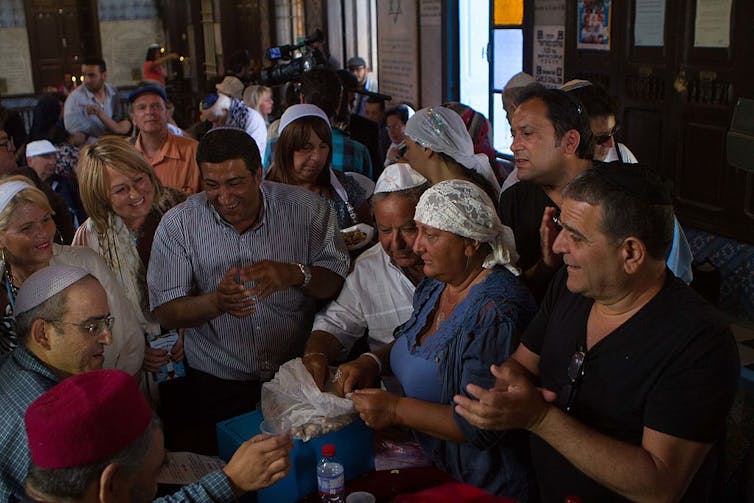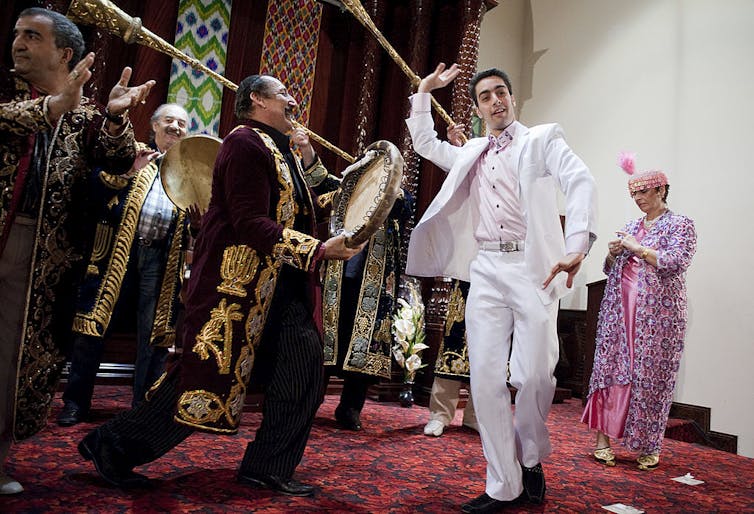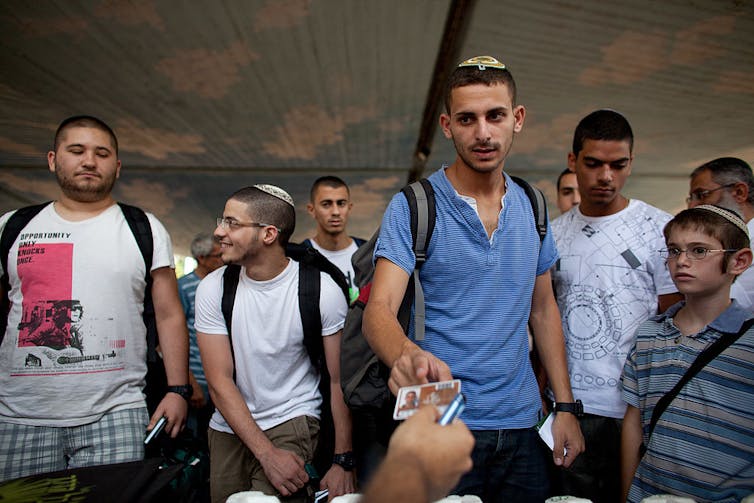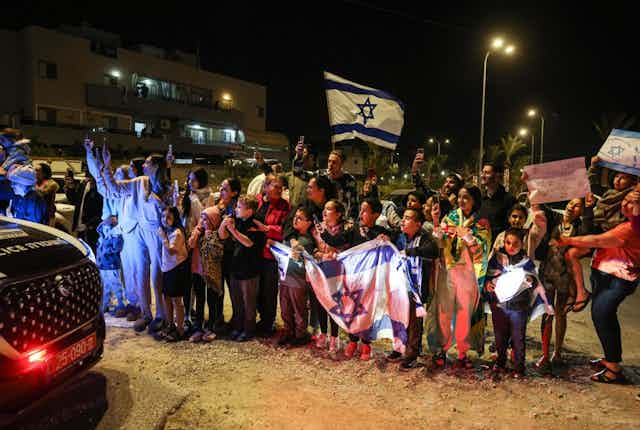Some 16 million people worldwide identify as Jewish – and more than 7 million of them live in Israel.
The country is home to more than 2 million people who are not Jewish, as well – primarily Arab Israelis, who make up 20% to 25% of the population, and more than 100,000 foreign workers. Most Arab Israeli citizens are Muslim, but small minorities adhere to various Christian denominations, as well as the Druze religion.
Even within Israel’s Jewish population, however, there is dizzying diversity. As a historian of Jewish identity, I believe that understanding that diversity is key to understanding Israelis’ behavior amid the current war in Gaza, as well as the country’s long-term resilience.
Many cultures, one people
Jews are not a “race,” but constitute a people or nation. Traditionally, Jewish texts often refer to the Jewish people as “Israel.”
DNA studies and archaeological evidence show that the Jewish people originated in the Middle East. Owing to Jews’ historical dispersion around the world however, Jews also belong to several Jewish ethnic groups, all of which are represented in the modern state of Israel.
The largest Jewish ethnic group in Israel, about 40% to 45% of the country’s total population, is called Mizrahi, which means “Eastern” in Hebrew. Mizrahi Jews’ ancestors hailed from Jewish communities in the Middle East, including Israel itself.
The word Mizrahi often describes Jews from North Africa, too. However, these Maghrebi Jews descend from different groups than other Mizrahi Jews. Some North African Jews’ ancestors came from local communities. Others migrated there from the Iberian Peninsula after Spain expelled its Jewish population in 1492.

The expulsion of these Sephardic communities, as Iberian Jews are called, scattered Sephardi culture throughout areas such as Greece, Turkey, the Balkans, Italy and Morocco. Thus, many Jews whose families came to these regions are genealogically and culturally Sephardi. Yet, Sephardi Jews also include people whose Jewish ancestors adopted the traditions of Iberian Jews.
The Israeli government’s record-keeping tends to lump Sephardi Jews under the Mizrahi category as well.
The second-largest ethnic Jewish group in Israel, about 32% of the population, is Ashkenazi. Ashkenazi Jews trace their ancestry to central Europe, most often via Eastern Europe.
Alongside these two dominant groups – Mizrahi and Ashkenazi – are Jews from unique communities that do not fit neatly into the two major subdivisions, yet sometimes find themselves included under the Mizrahi umbrella.
These include the Bene Israel of India; several groups of Kavkazi, or Caucasus Jews, referring to their origins in the Caucasus region of Central Asia; and Bukharan Jews of Uzbekistan. Other unique groups include Italian Jews and Ethiopian Jews.

Modern migrations
Modern times have witnessed sweeping migrations of Jews across the diaspora – and also migration to modern Israel.
For example, many Jews migrated from Europe and the Ottoman Empire to the Americas before and after the world wars: not only to the United States, but Latin America, especially Argentina, Brazil and Mexico.
Since the state of Israel’s founding in 1948, migration has flowed the other way as well. Today in Israel there are approximately 200,000 Jews from English-speaking countries and some 100,000 from Latin American countries.
Since the final years of of the Soviet Union, about 1 million people with Jewish roots have immigrated to Israel from Russia and the former Soviet bloc countries. They and their children now make up about 15% to 18% of the Israeli population.

As regards their approach to Jewish traditions and rabbinic law, Israelis range from the ultrasecularist to the Haredi, whose name means “trembling” before God – often referred to as ultra-Orthodox. There is no hard-and-fast correspondence, though, between Israelis’ ethnic identity and their level of traditional observance.
Some 50% of Israeli Jews may belong to ethnically mixed families. Nevertheless, in an age of identity politics, a trend toward ethnic tribalism has gripped Israel, complicating an older divide between left and right. Although the center-right Likud party of Prime Minister Benjamin Netanyahu has been led mostly by Ashkenazi Jews, it openly appeals to Sephardi and Mizrahi pride, as does the ultra-Orthodox Shas party.
Appeals to Mizrahi and Sephardi voters reflect a long-standing sense of discrimination among non-Ashkenazi Israelis. In Israel’s first few decades, predominantly Ashkenazi, socialist governments channeled hundreds of thousands of Mizrahi and Sephardi immigrants toward unskilled labor and peripheral development towns.
The phrase “The Second Israel” refers to the idea that non-Ashkenazi citizens are still marginalized by an Ashkenazi cultural establishment.
Tensions – and unity
Tribal factionalism, however, has a countervailing force: Zionism, the cultural and political ideology on which the country was founded.
As an ideology of national liberation, Zionism advocates Jews’ collective sovereignty and cultural renaissance in their ancestral homeland. Despite its diversity of political beliefs, ethnicities and religious observance, Jewish Israeli society ultimately holds together because of a widely shared Zionist patriotism.
This is expressed in what Israeli scholars Shmuel Rosner and Camil Fuchs call the civic culture of “Jewsraelis”: a largely secular yet semitraditional Jewishness that shapes public life in Israel. Jewsraelis, they argue, are proud citizens who are comfortable mixing Jewish tradition and modernity – from family meals on the Jewish Sabbath and Passover to beach barbecues and serving in the Israel Defense Forces, which is mandatory for most citizens.

Before the current war, Jewish Israelis by the hundreds of thousands had marched in the streets for nearly a year over government proposals to curtail the power of Israel’s Supreme Court. In the wake of Hamas’ horrific attacks on Oct. 7, 2023, however, those considerable tensions have been tabled. High numbers of Israelis have volunteered to go to the front or assist each other in other ways, such as donations or working on farms.
Notably, Jewish commandments and traditions put an emphasis on freeing Jewish captives, such as the people held hostage in Gaza.
Sharp debate continues among Jewish Israelis over the goals and scope of the war in Gaza.
Nevertheless, as has been true in other moments of national crisis, they have largely banded together for what they perceive to be the common national good. Although diverse and often divided from within, most Israeli Jews embrace the idea expressed in a popular song penned in the 1980s: “Ein li eretz aḥeret” – “I have no other (home)land.”

